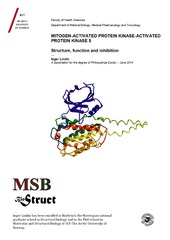Mitogen-activated protein kinase-activated protein kinase 5 - Structure, function and inhibition
Permanent link
https://hdl.handle.net/10037/6998View/
Thesis introduction (PDF)
Inger Lindin, Yimingjiang Wuxiuer, Irina Kufareva, Ruben Abagyan, Ugo Moens, Ingebrigt Sylte and Aina Westrheim Ravna: “Homology modeling and ligand docking of Mitogen-activated protein kinase-activated protein kinase 5 (MK5).” Theoretical Biology and Medical Modelling 2013, 10:56. Epub: 14 September 2013. Also available at http://dx.doi.org/10.1186/1742-4682-10-56 (PDF)
Inger Lindin, Ymingjiang Wuxiuer, Aina Westrheim Ravna, Ugo Moens and Ingebrigt Sylte: “Comparative molecular dynamics simulation of mitogen-activated protein kinase-activated protein kinase 5.” Int J Mol Sci. 2014 Mar 19;15(3):4878-902. Also available at http://dx.doi.org/10.3390/ijms15034878 (PDF)
Date
2014-09-26Type
Doctoral thesisDoktorgradsavhandling
Author
Lindin, IngerAbstract
Protein kinases have become central in the efforts to understand the nature of various diseases, and a lot is invested into creating effective therapeutic strategies and finding effective and selective protein kinase inhibitors. In order to succeed it is also important to focus on the structure of the kinases, their exact biological role, and how they interact and cooperate in the signaling. The exact structure of MAPKAPK5 is still unknown, and selective inhibitors are yet to be identified. Even though some of its biological roles are starting to emerge more work is required, including searching for selective inhibitors, analyzing its structure and interactions with its interaction partners.
In order to analyze the structure of MAPKAPK5, homology models were generated and their ability to discriminate between binders and non-binders were analyzed. Based on the results, one model was found satisfactory and may be used as a working tool for further experimental studies and possibly structure aided drug design. Further, interactions between MAPKAPK5 and its interaction partners were analyzed using molecular dynamic simulations. These studies showed that the previously created models were stable during simulations, and thereby robust and suitable for structural predictions. Simulation with MAPKAPK5 alone showed a stable kinase which maintained an active conformation. The simulations with an inhibitor indicated that the inhibitor binds to a MAPKAPK5 conformation consistent with an active protein kinase and thereby functions as an inhibitor by occupying the ATP binding site. The simulation with MAPKAPK5 in complex with the protein kinase p38 revealed that electrostatic interactions are important both for recognition and binding of p38, and that p38 bind to several areas in addition to the dedicated p38 binding site. This might be important when designing inhibitors which bind to other areas of MAPKAPK5 than the ATP binding pocket. Lastly, commercially available databases were searched for possible new MAPKAPK5 inhibitors. After computational and experimental testing several promising compounds were identified. These compounds might be a good starting point for synthesizing structurally modified analogues with improved potency and specificity and may contribute to further unraveling the functions of MAPKAPK5.
Description
Paper III of the thesis is not available in Munin:
III: Inger Lindin, Aina Westrheim Ravna, Sergiy Kostenko, Ingebrigt Sylte and Ugo Moens: “Discovery of Mitogen-activated protein kinase-activating kinase 5 inhibitors using virtual ligand screening”. (Manuscript)
III: Inger Lindin, Aina Westrheim Ravna, Sergiy Kostenko, Ingebrigt Sylte and Ugo Moens: “Discovery of Mitogen-activated protein kinase-activating kinase 5 inhibitors using virtual ligand screening”. (Manuscript)
Publisher
UiT The Arctic University of NorwayUiT Norges arktiske universitet
Metadata
Show full item recordCollections
Copyright 2014 The Author(s)
The following license file are associated with this item:


 English
English norsk
norsk
